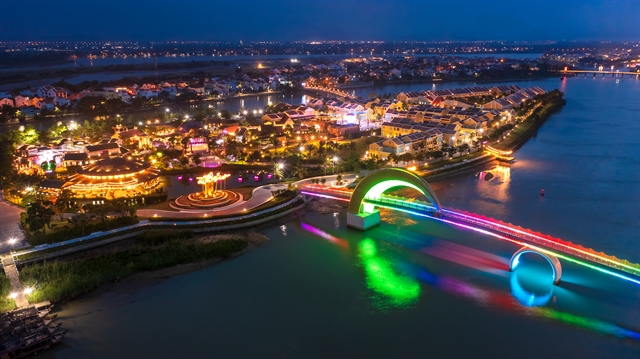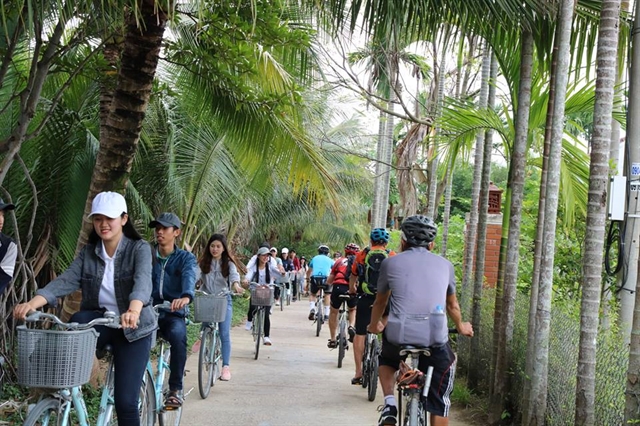
The UNECO-recognised world heritage site of Hội An ancient town has been designed as an eco-city, cultural and sustainable tourism concentrated urban area in 2030, with a vision to becoming a ‘green’ and ‘smart’ city in 2050.
Chairman of Hội An City’s People’s Committee, Nguyễn Văn Sơn shared about the city’s Master Plan 2021-30, vision 2050, in a working session with Quảng Nam provincial leadership, stressing that heritage preservation and unique culture and nature conservation are top priority and a key basis of the sustainable development target.
He said Hội An has been preserving heritage for decades, it still keeps the ancient value as a key foundation for sustainable growth in the new wave of development.
“We focus on heritage preservation for growth, and reserve funds for conservation and restoration of relics and heritage. The Master Plan also recognised the important role of heritage restoration as a top priority among investment items,” Sơn said.
Architect Lương Ngọc Trung, design director of Arep Ville company from France, involved in Hội An Master Plan development, said Hội An aims to be a second class urban area in 2030 before reaching ‘smart’ city standard in 2050.
He said the ancient town will be designed as an eco-city, an international culture-based destination on the basic terms of unique tradition, sustainability and climate change resilience, emerging a ‘smart’ urban zone linked with Điện Bàn Town, Tam Kỳ City and Núi Thành district, and boosting ‘smart’ and ‘green’ tourism service.

The plan unveiled that Hội An is designed for 160,000 population on 2,841ha in 2030, and will expand to 3,274ha for a population of 230,000 by 2050.
Hội An will reserve development space to the west including Thanh Hà pottery village and Cẩm Hà botanic garden zone.
Earlier this year, the central Quảng Nam province proposed an overall restoration plan for Hội An ancient town and relics requiring an estimate fund of VNĐ1.67 trillion (US$66.8 million) in 2030-35.
The ancient town, which was recognised as a world heritage site by UNESCO in 1999, has 1,439 relics and old houses, of which 80 per cent belong to the Old Quarter, built 100 to 200 years ago.
Hội An has been boosting co-operation with Japan International Co-operation Agency (JICA) in restoration of the centuries-old Japanese Bridge – a symbol of Hội An and the Việt Nam-Japan friendship.
The ancient town is the most attractive destination in central Việt Nam, hosting 13.5 million tourists in 2018-22.
Hội An City officially became a member of the UNESCO Creative Cities Network (UCCN) in the Crafts and Folk Art category in 2023.

Previously, many traditional festivals in the old town were recognised as national heritages including the Mid-Autumn Full Moon Festival and the annual Nguyên Tiêu (full moon of lunar January) Festival, as well as Thanh Châu bird’s nest, Thanh Hà Pottery Village, the carpentry trade of Kim Bồng Village, and the Trà Quế vegetable garden.
Two crafts – hammock weaving from tree bark (Firmiana colorata) and the craft of making houses from bamboo and nipa-palm – were also listed in the national intangible heritage.
The town has been promoting ‘green’ and sustainable tourism with zero-waste, non-plastic and low carbon policies.
Experts from Japan International Co-operation Agency (JICA) and Việt Nam have been repairing and strengthening the structure of the centuries-old Japanese Bridge – a symbol of Hội An and the Việt Nam-Japan friendship.
Naha city, the capital of Okinawa Prefecture, also supported Hội An with the Eco-city Achievement Support Project in building the town as an eco-tour site.
Hội An ancient town is the most attractive destination in central Việt Nam, hosting 13.5 million tourists in 2018-22.

The town has been promoting ‘green’ and sustainable tourism with zero-waste, non-plastic and low carbon policies, a bicycle and non-smoking destination.
The Chàm Islands-Hội An area, recognised as a world biosphere reserve by UNESCO in 2009, and Cẩm Thanh Commune – home to precious nipa palm swamps in the rich ecological system of wetlands – are joined the Master Plan as key ‘ecological’ core zones.
Covering an area of 60sq.km, the tourism hub has developed 22.5sq.km with agriculture and forests and 11sq.km with lakes and channels.
The city also plans to provide 100,000 bicycles for residents in order to become the first eco-city in Việt Nam.
Four Paws animal charity and Hội An agreed on a memorandum of understanding in building the town as a tourist-friendly, free of dog and cat meat and supporting rabies elimination.
(VNS)




